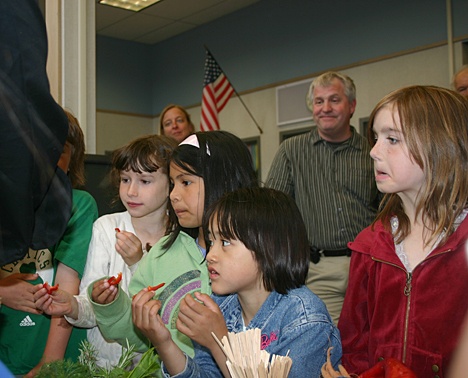By LIZ BURLINGAME
For The Journal of the San Juan Islands
A pilot program had San Juan Island schools tossing out the mystery meat in exchange for fresh, in-season cafeteria food last year, and officials assure it will stay the same in the 2009-10 school year.
However, Superintendent Walt Wegener said the school district will now take control of the lunch program.
“We looked at the system and high quality employees and opportunities for the community and farmers on the island and said ‘Hey, maybe we can run this ourselves,'” Wegener said.
Last year, the lunch program was headed by members of the Experience Food Project which was launched by Chef Tom French of Whidbey Island. He describes his program as a “radical change in school food culture.” Instead of buying pre-packaged goods or foods in bulk-sized cans, French’s system involved obtaining fresh food locally.
The new menus eliminated high fructose corn syrup, most artificial dyes and growth hormones in milk, French said.
For start-up costs, including the hire of an executive chef, the program was funded by local contributions from the San Juan Island Community Foundation, among others. This year, the program is funded by lunch sales. The district is yet to break even, Wegener said.
“We don’t see it as a revenue source,” Wegener said, adding that he hopes it will become more financially viable. The program is set to last for at least three years.
Friday Harbor High School Principal Fred Woods expects the program to do well financially this year. “Receipts were so much higher (in 2008-09),” he said. “We fed well over half of the district last year.”
Woods said high school lunches are $3.50, middle and elementary school lunches are $3.25. All three schools also offer breakfast for $2. “It’s still the best deal in town,” he said.
For the next 120 days, the school district will run the lunch program independently, then consult with French.
The school district originally moved from a traditional, federal program to a pilot program after financial cutbacks. The district considered shutting down its hot lunch program in 2007, before they met with French.
French saw San Juan schools as a chance to experiment. He piloted farm-to-institution programs in schools in King County and Anacortes, but he only had access to one or two areas in things such as operations, growers and food education. It would simultaneously test each of the organization’s best projects.
“Everything was working in concert,” he said of San Juan.
Many food products were purchased from farmers within a 25-mile radius of the school district. Wegener said the program advanced more quickly than they expected, because of the island’s unique market. With few big-name fast-food chains, more students were turning to school lunches. It’s currently more cost effective than the former federal program, Wegener said.
“From day one, the kids were really psyched,” French said. “It went from low to high participation.”
In mid-October, French plans to release a set of findings for the first-year of the pilot program online. He will try to determine ways the model can be applied and modified for other small districts.
By the end of 120 days, the lunch program could become a standalone project, with possible renaming by the school district, or officials could seek further direction from Experience Food Project.
In any case, the food service will remain “the same as it was last year,” Wegener said.
“We still want a high quality meal, but we’re stepping up and taking more responsibility,” Wegener said.
Funding partners include Steve and Connie Ballmer, San Juan Island Community Foundation, and the San Juan Island School District.
Local agencies and businesses involved in advising or supplying the program include Heuristic Enterprise; Island Certified Local; San Juan County Agricultural Guild; San Juan Island Farmers Market; WSU Master Gardeners’ Association; The Market Chef; Draper Valley Farm, Skagit Valley; Edaleen Dairy, Skagit Valley; Fir Oak Farm, San Juan Island; Griffin Bay Fisheries, San Juan Island; Island Grown Farmers’ Cooperative, San Juan Island; Lacrover Farm, San Juan Island; Little S Farm, San Juan Island; Nootka Rose Farm, Waldron Island; Pleasant Valley Farm, Skagit Valley; Quail Croft Farm, San Juan Island; Skagit Fresh, Skagit Valley; and Skagit Valley Berries, Skagit Valley.
— Liz Burlingame is a reporter for the Whidbey News-Times, a sister newspaper of The Journal.



